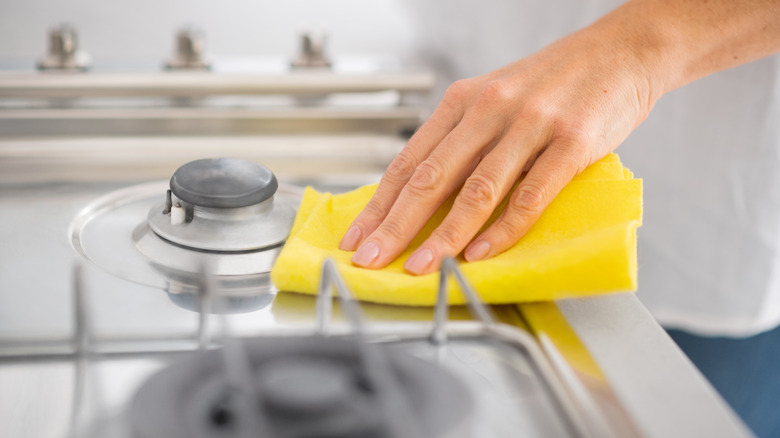Best Way to Clean Stove Top: Guide to a Sparkling Kitchen
I. Introduction to Cleaning Stove Tops
![5 Best Oven Cleaner for Self Cleaning Ovens [2021]](https://ts1.cn.mm.bing.net/th/id/R-C.aee5c9c634a7a0dd3c5fc63b56d43379?rik=LWkiYPboG5wlwA&riu=http%3a%2f%2fkitchencookwarereviews.com%2fwp-content%2fuploads%2fbest-oven-cleaner-for-self-cleaning-ovens-scaled.jpg&ehk=9hEa6mIuSO5G%2bw8lbi4O0Gj6zSfnr2HExZwOlSobMoM%3d&risl=&pid=ImgRaw&r=0)
A. Importance of Regular Cleaning for Stove Top Maintenance
Regular cleaning of stove tops is important for maintaining their appearance, functionality, and longevity. Cleaning removes food residues, grease, and stains that can accumulate over time and affect the performance of the stove top.
B. Understanding Different Stove Top Materials and Cleaning Considerations
Different stove tops are made from various materials, such as glass, ceramic, gas burners, or electric coils. Each material requires specific cleaning methods and products to ensure proper care without damaging the surface.
C. Benefits of Adopting Effective Cleaning Methods
Effective cleaning methods not only keep the stove top looking clean and presentable, but they also ensure safe cooking by preventing the buildup of flammable residues. Regular cleaning can also improve the efficiency of heat transfer and prevent the growth of bacteria or mold.
II. Gathering the Necessary Supplies
A. Identifying Cleaning Agents and Tools
- Exploring Suitable Cleaning Agents for Stove Tops
Suitable cleaning agents for stove tops may include mild dish soap, baking soda, vinegar, commercial stove top cleaners, or specialized cleaning products recommended by the stove manufacturer.
- Identifying Essential Cleaning Tools for Effective Cleaning
Essential cleaning tools may include microfiber cloths, non-abrasive sponges or scrub brushes, old toothbrushes, plastic or silicone scrapers, and gloves for hand protection.
III. Preparing the Stove Top for Cleaning
A. Clearing the Surface and Removing Loose Debris
- Wiping Away Loose Food Particles and Debris
Before cleaning, remove any loose food particles or debris from the stove top surface using a dry cloth or paper towel.
- Removing Removable Stove Top Components for Thorough Cleaning
If applicable, remove removable stove top components such as burner grates, drip pans, or knobs. This allows for more thorough cleaning and prevents cleaning agents from damaging these components.
IV. Cleaning Methods for Different Stove Top Materials
A. Cleaning a Glass or Ceramic Stove Top
- Understanding Gentle Cleaning Techniques and Products
For glass or ceramic stove tops, use gentle cleaning techniques to prevent scratching or damaging the surface. Avoid using harsh or abrasive cleaners that can cause permanent damage. Instead, use a soft cloth or sponge with a mild dish soap solution or a specialized glass/ceramic cleaner.
- Identifying Non-Abrasive Scrubbing Tools for Glass or Ceramic Surfaces
Use non-abrasive tools, such as non-scratch sponges or soft microfiber cloths, to gently scrub away stains or residue. Avoid using metal scrubbers or brushes that can scratch the glass or ceramic surface.
B. Cleaning a Gas or Electric Coil Stove Top
- Exploring Techniques for Removing Stains and Burnt-on Residue
For gas or electric coil stove tops, removing stains and burnt-on residue may require slightly more aggressive cleaning. Use a mild dish soap solution or a specialized stove top cleaner to break down grease and grime. Scrub gently with a non-abrasive sponge or brush.
- Identifying Suitable Cleaning Agents for Gas or Electric Coil Surfaces
For gas or electric coil stove tops, avoid letting liquid cleaners seep into the burners or electrical elements. Instead, apply the cleaning solution to the sponge or cloth and then clean the surface. Be sure to follow any specific cleaning recommendations provided by the stove manufacturer.
V. Removing Stubborn Stains and Burnt-on Residue
A. Dealing with Grease Buildup and Burnt Food Deposits
- Exploring Effective Degreasing Agents and Techniques
For stubborn grease buildup or burnt food deposits, use specialized degreasing agents or a paste made from baking soda and water. Apply the cleaner to the surface, let it sit for a few minutes, then scrub gently with a non-abrasive sponge or brush.
- Identifying Gentle Scrubbing Tools for Stubborn Stains
To remove stubborn stains, use non-abrasive scrubbing tools such as a non-scratch sponge or brush. Avoid using sharp objects or abrasive materials that can scratch or damage the stove top surface.
B. Handling Tough-to-Clean Areas, such as Burner Grates or Drip Pans
- Discovering Specialized Cleaning Methods for Specific Stove Top Components
For tough-to-clean areas such as burner grates or drip pans, consider using specialized cleaning methods. Soaking these components in a mixture of warm water and dish soap or vinegar can help loosen stubborn grime before scrubbing with a non-abrasive brush or sponge.
- Exploring Soaking Techniques for Deep Cleaning
For deep cleaning, soak removable stove top components in a sink or tub filled with warm water and a cleaning solution. Let them sit for a few hours or overnight before scrubbing away any remaining residue. Rinse thoroughly and dry before reattaching them to the stove top.
Cleaning your stove top regularly is essential for maintaining a clean and hygienic kitchen. By following a step-by-step guide and using suitable cleaning agents and tools, you can ensure a sparkling stove top surface. Whether you have a glass, ceramic, gas, or electric coil stove top, adopting specific cleaning techniques for each material will yield the best results. Removing stubborn stains and practicing regular maintenance will help prolong the life of your stove top and maintain its appearance. With proper care and attention, you can enjoy a clean and functional stove top in your kitchen.
